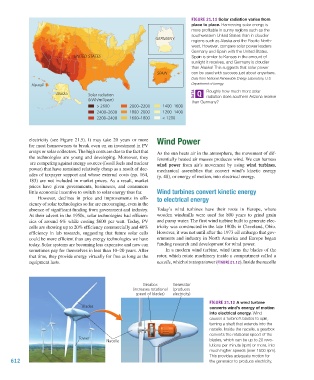Page 613 - Environment: The Science Behind the Stories
P. 613
Figure 21.11 Solar radiation varies from
place to place. Harnessing solar energy is
more profitable in sunny regions such as the
southwestern United States than in cloudier
GERMANY
regions such as Alaska and the Pacific North-
west. However, compare solar power leaders
Germany and Spain with the United States.
UNITED STATES Spain is similar to Kansas in the amount of
sunlight it receives, and Germany is cloudier
than Alaska! This suggests that solar power
SPAIN can be used with success just about anywhere.
Data from National Renewable Energy Laboratory, U.S.
Hawaii Department of Energy.
Roughly how much more solar
Alaska Solar radiation radiation does southern Arizona receive
(kWh/m 2 /year) than Germany?
> 2600 2000–2200 1400–1600
2400–2600 1800–2000 1200–1400
2200–2400 1600–1800 < 1200
electricity (see Figure 21.5). It may take 20 years or more Wind Power
for most homeowners to break even on an investment in PV
arrays or solar collectors. The high costs are due to the fact that As the sun heats air in the atmosphere, the movement of dif-
the technologies are young and developing. Moreover, they ferentially heated air masses produces wind. We can harness
are competing against energy sources (fossil fuels and nuclear wind power from air’s movement by using wind turbines,
power) that have remained relatively cheap as a result of dec- mechanical assemblies that convert wind’s kinetic energy
ades of taxpayer support and whose external costs (pp. 164, (p. 48), or energy of motion, into electrical energy.
183) are not included in market prices. As a result, market
prices have given governments, businesses, and consumers
little economic incentive to switch to solar energy thus far. Wind turbines convert kinetic energy
However, declines in price and improvements in effi- to electrical energy
ciency of solar technologies so far are encouraging, even in the
absence of significant funding from government and industry. Today’s wind turbines have their roots in Europe, where
At their advent in the 1950s, solar technologies had efficien- wooden windmills were used for 800 years to grind grain
cies of around 6% while costing $600 per watt. Today, PV and pump water. The first wind turbine built to generate elec-
cells are showing up to 20% efficiency commercially and 40% tricity was constructed in the late 1800s in Cleveland, Ohio.
efficiency in lab research, suggesting that future solar cells However, it was not until after the 1973 oil embargo that gov-
could be more efficient than any energy technologies we have ernments and industry in North America and Europe began
today. Solar systems are becoming less expensive and now can funding research and development for wind power.
sometimes pay for themselves in less than 10–20 years. After In a modern wind turbine, wind turns the blades of the
that time, they provide energy virtually for free as long as the rotor, which rotate machinery inside a compartment called a
equipment lasts. nacelle, which sits atop a tower (Figure 21.12). Inside the nacelle
Gearbox Generator
(increases rotational (produces
speed of blades) electricity)
Figure 21.12 A wind turbine
Blades converts wind’s energy of motion
into electrical energy. Wind
causes a turbine’s blades to spin,
turning a shaft that extends into the
nacelle. Inside the nacelle, a gearbox
converts the rotational speed of the
Tower
Nacelle blades, which can be up to 20 revo-
lutions per minute (rpm) or more, into
much higher speeds (over 1500 rpm).
This provides adequate motion for
612 the generator to produce electricity.
M21_WITH7428_05_SE_C21.indd 612 12/12/14 4:29 PM

